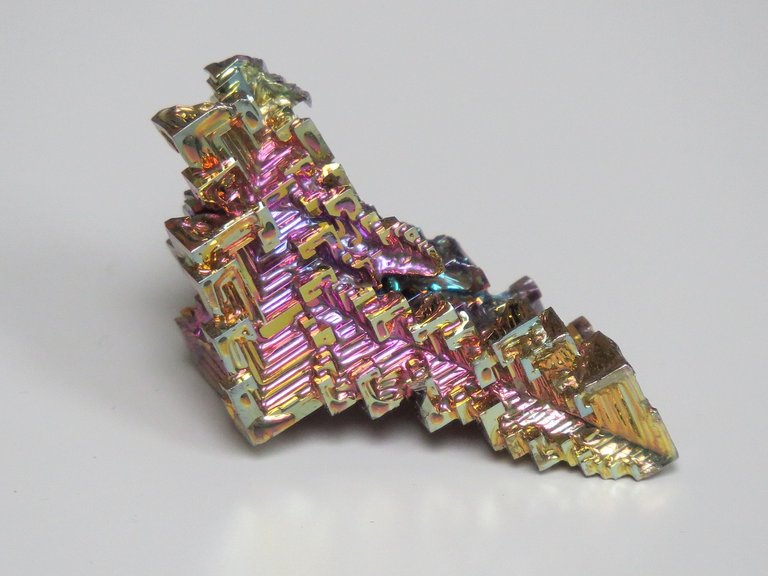Bismuth is a chemical element that has been gaining popularity in the beauty industry. This silvery-white metal was first discovered in 1753, and it's known for its unique crystal structure. Unlike other metals, bismuth forms beautiful, iridescent crystals that shimmer with rainbow-like colors. These crystals are formed by heating bismuth until it melts and then allowing it to cool slowly.
The stunning beauty of bismuth crystals has attracted many people who love to collect and display them. Bismuth is often used in jewelry-making because of its unique properties. It can be easily molded into different shapes and sizes, making it perfect for creating intricate designs. Its iridescent shine also adds an extra touch of glamour to any piece of jewelry.

Apart from its aesthetic appeal, bismuth also has several practical uses. It is often used in the manufacturing of alloys, which are used in the production of various industrial products such as fire sprinkler systems and electrical fuses. Bismuth is also commonly found in cosmetics like lipstick and nail polish due to its non-toxic nature and ability to produce a pearlescent finish when combined with other ingredients.
Brief History:
Bismuth is a chemical element that has been known since ancient times. The ancient Egyptians, Greeks and Romans used bismuth compounds for cosmetics, medicine and even as a decoration on their pottery. However, it was not until the 18th century that bismuth was recognized as a distinct element by Claude Geoffroy the Younger.
In the early 19th century, scientists began to investigate the crystal structure of various minerals including bismuth. French mineralogist Jean-Baptiste Léonce Élie de Beaumont described the rhombohedral crystal structure of native bismuth in 1821. It wasn't until over a century later in 1914 when Paul Groth published his book on crystallography that he detailed how this unique crystal structure arises from four-fold spirals of atoms.
Today, bismuth remains an important element for its use in cosmetics, pharmaceuticals and alloys with other metals. Its beautiful iridescence also makes it popular among collectors of minerals and crystals. Despite being discovered thousands of years ago, there is still much to learn about this fascinating element and its unique properties.
Crystal Structure:
Bismuth is a chemical element that has always been known for its fascinating properties. Among these, the most notable is its unique crystal structure. Unlike many other metals, bismuth's crystal structure is not simple cubic or hexagonal but rather rhombohedral. This means its crystals are shaped like cubes with one corner cut off at an angle.
The radiance of bismuth arises from the different colors it reflects when under various light sources and angles, and this property has made it a popular choice for jewelry and decor items. The iridescence comes from the way light waves scatter as they pass through the thin oxide layer that forms on top of Bismuth's surface when it reacts with air. The thickness of this layer varies across the surface of bismuth; hence, different colors appear in different regions.
Scientists have studied Bismuth's crystal structure to understand how it contributes to its unique properties. They have found that the rhombohedral shape of Bismuth crystals creates distinctive patterns in their electronic band structures that give rise to intriguing properties such as high electrical conductivity and diamagnetism (the ability to repel magnetic fields). Understanding these characteristics can help researchers develop new materials for various applications such as electronics, energy storage systems, and more.
Applications:
Bismuth has a variety of applications due to its unique properties and crystal structure. For example, the metal is often used in cosmetics because it creates a bright and radiant effect on the skin. Additionally, bismuth is also used in pharmaceuticals as an antacid and stomach protectant due to its ability to coat the lining of the stomach.
In electronics, bismuth is added to alloys to improve their machinability and reduce their melting point. It can also be used as a substitute for lead in shoulders due to its non-toxic nature. Bismuth's low thermal conductivity makes it useful in thermoelectric devices such as power generators and refrigeration units.
Overall, bismuth may not be as well-known or widely-used as other metals, but its unique properties make it valuable in a variety of industries from cosmetics to electronics. Its beauty extends beyond just its physical appearance, making it an important element for modern technology and medicine.
Natural Occurrence:
Bismuth is a rare metal that occurs naturally in the Earth's crust. It is typically found in small quantities, often as bismuthinite or bismite minerals. Bismuth has unique physical and chemical properties, which make it an interesting and valuable element for various industries.
One of the most striking features of bismuth is its crystal structure. Unlike other metals, such as copper or silver, which form simple cubic or hexagonal structures, bismuth forms highly complex rhombohedral crystals that resemble colorful staircases. These crystals are a result of the way atoms of bismuth pack together in a lattice pattern.
Bismuth also exhibits some unusual magnetic and electrical properties due to its spin-orbit coupling effect, which arises from the interaction between its electrons' motion and their spin orientation. This property makes it useful for various industrial applications like alloys used in fire sprinklers and electrical fuses. In addition to this, bismuth compounds have been found to possess antimicrobial properties with potential applications in medicine and agriculture.